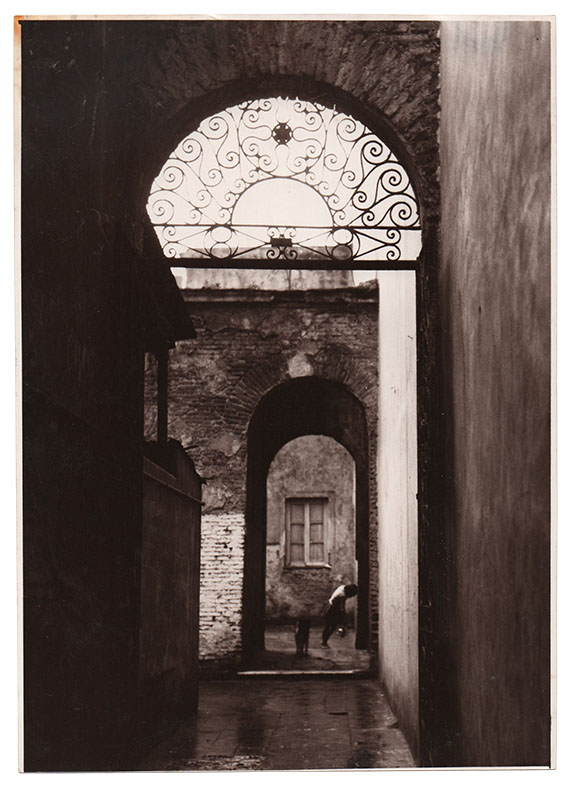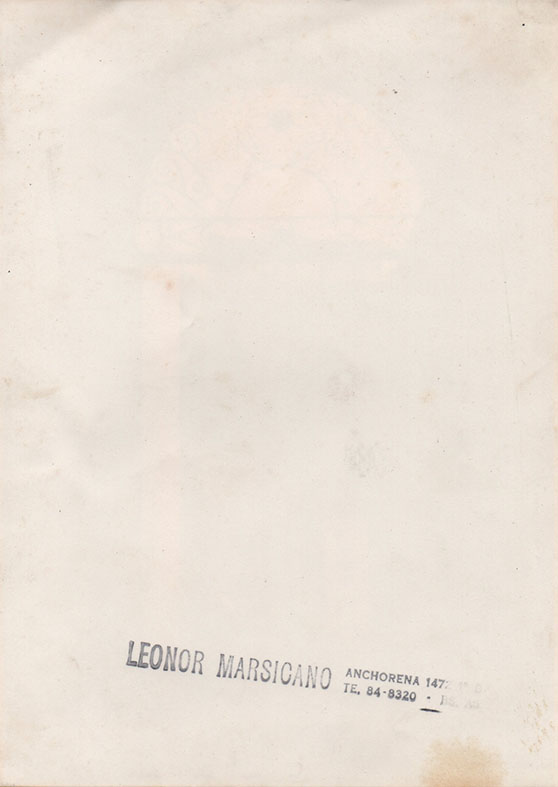Zaguán de San Telmo. Circa 1975.
Vintage gelatin silver print. Measurements: 23.8 x 17 cm / 9.37 x 6.7 in. On the back the artist's wet stamp: “Leonor Marsicano. Anchorena 1472. T.E. 84.8320".
Interior of an old chorizo house, a typical communal house in San Telmo. A natural space for immigrants, with its patios, and its perspectives of arcades and forged ironwork, it was one of the settings in our Buenos Aires history at the end of the 19th century and the first decades of the 20th that inspired so many writers, poets, musicians, and of course it is, to photographers, as is the case of Leonor Marsicano. The water on the walls and floors accentuates every detail of the shot, while flooding the moment with melancholy. Two mysterious characters inhabit this space, a leaning girl fills a kettle from a community tap while a dog looks at her… “When she appears, people are not in the center of the scene; it is part of it, it flies over the landscape, merging with it”. (1)
The book Buenos Aires al Sur. Imágenes de San Telmo y más allá... (Buenos Aires. Ed. Gaglianone. 1993) reproduces this photograph. Leonor chose the following poem by Raúl González Tuñón to accompany her, one of her Poetangos: “From the obstinate hand of the bronze caller / stopped in time without a door and without a destination / and from the inner courtyard of silence / and depth from the piers / where dreams not yet dreamed await / the subtle call of terrible children / and the lost seagull knocks / with its shadow wing the door of day, / Oblivion comes and sits down to rest”.
Note:
1. Camilo Sánchez in the preliminary words of the book Buenos Aires al Sur. Imágenes de San Telmo y más allá...
LEONOR MARSICANO
Leonor Martínez Baroja (Cenicero, La Rioja, Spain, 1926), with the surname of her mother, was here known as Leonor Marsicano, adopting that of her husband. She emigrated to Buenos Aires at the age of three with her mother and her older sister; but at ten she returned to Spain and returned to Argentina in 1943, at the age of fifteen. Those were difficult times, she worked as a maid, like her mother, although she already wanted to be an artist. Years later, she joined the communist party and there she met her husband. Interested in photography and cinema, a comrade from the party gave her the address of the Russian photographer Anatole Saderman. Leonor became her assistant and Anatole her teacher.
As her teacher, she was a great portraitist. She immortalized among others Sabato, Piazzolla, the painters Carlos Alonso, Carlos Castagnino, Demetrio Urruchúa and Raquel Forner, the sculptor Antonio Pujía and the dancer María Fux. Interested in the political life of her time, she recorded the first appearances of the Mothers of the Plaza de Mayo, and worked for the cultural newspaper Purposses, edited by the writer and playwright Leónidas Barletta.
The other great area of interest of her was the architecture of the city, especially the most neglected. In 1993 she published the book Buenos Aires al Sur. Images of San Telmo and beyond ..., a collection of 27 views of the dizzying 70s, of the “South of Buenos Aires, which is waiting, crouched behind the back of the city. Tango and taciturn south, whose most certain medal has to do with pride and history”. (1) A set of photographs centered on the San Telmo neighborhood, which were exhibited for the last time at the Technology and Humanism Foundation in 1996. The publication was accompanied by poems by Raúl González Tuñón and texts by Camilo Sánchez. She had previously participated in other volumes, such as Forte. The joy of painting (1979) by César Magrini.
At 87 years old, already a widow, she returned to her country to reside in Madrid. Disappointed by the mistreatment received by the Ministry of Culture of Argentina, she is currently looking for an institution that collects and takes responsibility for her legacy, more than forty years of photographs of our country and our people in times when the work of women photographers was not usual, standing out with Grete Stern and Annemarie Heinrich. It was her wish, we read in Spanish articles with interviews that were carried out in 2016 and 2017, that a book of hers be published, and what is collected "serves to investigate the tomb of Lorca, and for the southern neighborhood of Buenos Aires" . (2)
We now present two precious records of her authorship, high quality works with traces of the splendor lost in the Buenos Aires architecture of San Telmo.
Notes:
1. Camilo Sánchez in the preliminary words of the book Buenos Aires al Sur. Imágenes de San Telmo y más allá ...
2. Articles published in Spanish media: El Mundo, by Roberto Bécares (12/11/2016) and in La Rioja.com by Diego Marín (1/17/2017).
| AUTHOR | MARSICANO, LEONOR |
|---|---|
| ITEM | 25 |
Are you interested in selling some works?
Send us an email briefly indicating
which works you intend to put on sale, and we will respond. click here
Subscribe to our newsletter to be updated.
Check our Newsletters
